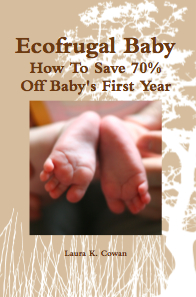'Ecofrugal' parenting: 10 reasons why being thrifty and 'green' is good for families and the planet

Each week as I leave the grocery store, my cart brimming with provisions, I try not to think about the ginormous hole I've just blown in the bank account.
How is it, I wonder, that my mother could feed a family of five on less than $50 a week? She was always cooking for other people, too: sick neighbors, church potlucks and an endless line of her children's friends. My friend Larry stopped by so often, she would hear his van pull in our driveway and have a pan of biscuits in the oven by the time the doorbell rang.
Lately — out of necessity — I've been trying to emulate some of my mother's temperate ways. (In this case "temperance" refers to the ability to moderate one's use of resources, becoming neither stingy nor overly lavish in consumption.) While children are a gift from God, raising and feeding and educating them does tend to take a bite out the budget. This article on eHow estimates that for families making between $40,000 and $70,000 a year, it can cost an average of $250,000 to raise a child to age 17! Six years ago, the U.S. Department of Agriculture put the estimate a bit higher, closer to $268,000.
The "sticker shock" can take a toll on family life, but there's good news. Some have discovered that it is possible to significantly reduce this figure through green, frugal parenting. These families are raising healthy, happy families while conserving both their environment and their savings.
Local author and frugal green parent Laura Cowan, who blogs at 29Diapers, has recently published "Ecofrugal Baby: How To Save 70% Off Baby’s First Year." Cowan offers the following reasons why becoming "green and lean" is good not only for the planet, but for families as well.
1. Use financial wisdom. Children's clothes and baby gear may often be purchased gently used or for free through other parents or Freecycle. "Being a thrifty parent isn’t about clipping coupons. Making thrifty choices where it makes a big difference can really change your finances," Cowan wrote.
2. Thrift is green. Many thrifty parenting choices such as cloth diapering not only save new parents $1,000 per year per kid, but also keep one ton of plastic diapers out of the landfill per kid every year.
3. Thrift spills over. When you’re watching what you spend on stuff for your kids, you tend to be more aware of what you spend in other areas as well. This leads to tidier and more focused finances.
4. Do what I do. Kids learn from watching their parents’ behavior, and thrifty parenting teaches them how to live their own lives as responsible, wise citizens. Kids of thrifty parents usually don’t have to be bailed out of credit card debt because they know how to manage their finances from an early age.
5. Thrift snowballs. When you start being thrifty and paying down debt, your progress snowballs as you take money you were putting toward debt and start saving and investing and changing your family’s finances. Dream big again!
6. Save the planet! Thrifty, green parenting changes the way children view their responsibility to care for the earth and their own lives. Thrifty parents can truly change the world through raising up the next generation to live responsibly and sustainably.
7. Win-win. Many thrifty parenting choices not only conserve resources, but improve the child's quality of life as well! Breastfeeding, for example, is the best nutrition for baby, it saves $1,500 to $2,000 per year on formula, and it reduces manufacturing waste and trash caused by all those formula containers being thrown out every week by millions of parents.
8. A penny saved. A penny saved is … well, it’s about 1.3 cents earned, actually. The money thrifty parents save is multiplied. They don’t have to pay income tax on the income they didn’t need to pay for baby gear. A parent staying home to raise a child saved more than the $14,000 in day care costs—they actually saved $18,200 (assuming a 30 percent tax bracket) because they would have to have earned $18,200 to take home $14,000 (after taxes).
9. And the beat keeps running. The savings from the first child is multipled with each additional child. Kid number two can reuse cloth diapers, wear hand-me-downs and use the same stroller you purchased for 70 percent off (combining coupon, clearance and free shipping deal). Cha-ching!
10. Thrifty parenting Is sneaky. Thrifty parents don't tote around kids in rags. Many families have so much stuff that hand-me-downs come with tags still attached and baby carriers were only used twice. You may be living next door to a millionaire who dresses her kids in hand-me-downs and buys certified used cars. Many thrifty parents are gaming the system and getting ahead by making smart and green choices.
Would you like to find out more about eco-frugal parenting? Cowen will be giving a free talk and book signing at the Barnes & Noble on Washtenaw Avenue in Ann Arbor at 4 p.m. Nov. 7.
If you would like a copy of the book but can’t make the book signing, you can order "Ecofrugal Baby" on her blog and specify a custom autographed message.
Heidi Hess Saxton is a contributing writer for the AnnArbor.com "parenting" channel and a graduate student at Sacred Heart Major Seminary in Detroit. She blogs at Extraordinary Moms Network, and can be reached at heidi.hess.saxton@gmail.com.


Comments
Heidi Hess Saxton
Mon, Nov 1, 2010 : 10:39 p.m.
Thanks, Jessica. I think a lot of people in Michigan are in the "cost trimming" mode. Books like this can help!